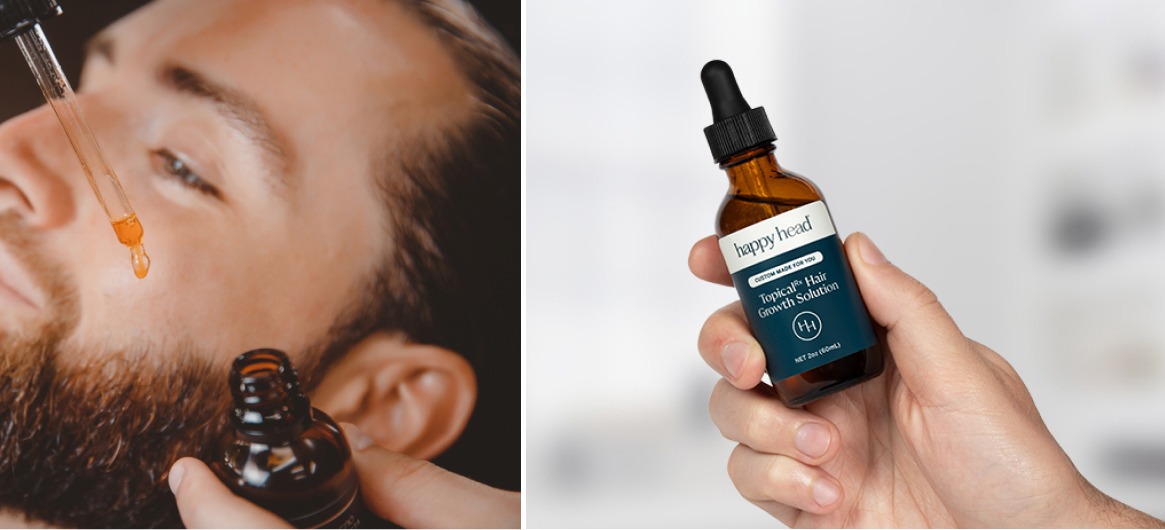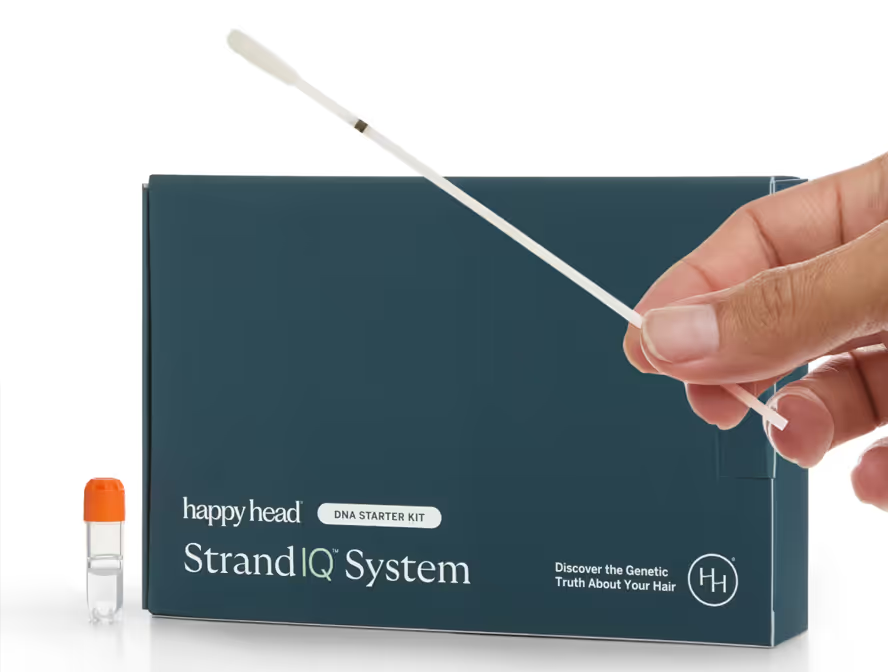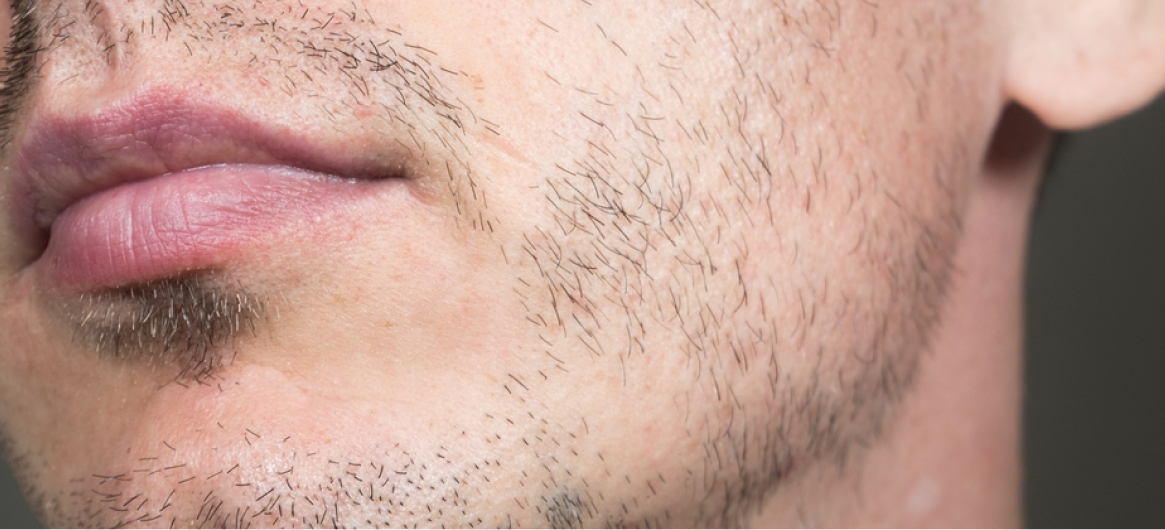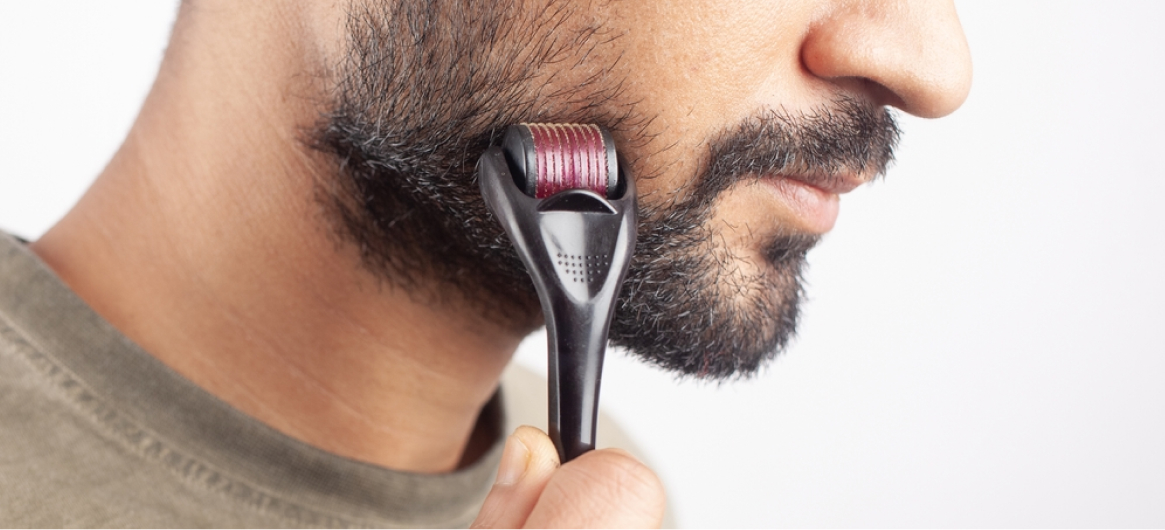Patchy beard growth can be frustrating for men who hope to achieve a fuller, more even beard. Uneven facial hair often reflects a combination of genetics, hormones, age, and lifestyle factors.
While some causes are beyond personal control, many strategies exist to improve density and appearance, from natural methods and smart grooming to beard formulas with minoxidil guided by dermatologists.
Causes of Patchy Beard Growth
Understanding the reasons behind patchy beard growth is essential for identifying the best approach to improvement. A variety of genetic, hormonal, health, and lifestyle factors can influence how facial hair develops and fills in over time.
Genetics
Genetics is one of the most common reasons for patchy beard growth. The density, thickness, and distribution of facial hair follicles are largely inherited. Some men naturally have fewer active follicles in the beard area, making growth appear uneven.
While this cannot be permanently altered without transplantation, knowing the genetic influence helps set realistic expectations. Medical treatments may stimulate dormant follicles, but genetics often determine baseline growth potential.
Age
Age can be a determining factor in how beards develop. Many men in their late teens and early twenties experience patchy growth simply because their hair follicles have not yet fully matured. Beard density often continues improving into the late twenties or early thirties.
If patchiness persists beyond this age range, it may point to genetic or hormonal influences rather than delayed development. Patience, combined with healthy habits, often improves beard fullness naturally over time.
Hormones
Testosterone and dihydrotestosterone (DHT) directly influence beard development. Even with normal hormone levels, follicles may vary in sensitivity to these hormones, causing uneven or sparse areas.
Low testosterone levels can contribute to patchiness, but are not the most common reason. Blood tests can confirm whether hormones are contributing, and treatment may involve medical intervention.
Because hormone-related growth is complex, addressing imbalances should only be done under the guidance of a qualified dermatologist or other healthcare professional.
Alopecia Barbae
Alopecia barbae is an autoimmune condition where the immune system mistakenly attacks beard hair follicles, leading to smooth, round patches of hair loss. Unlike genetic patchiness, these areas are usually well defined and may spread if untreated.
The condition can be unpredictable, with some men experiencing regrowth while others do not.
Dermatologists may recommend corticosteroid injections, topical immunotherapy, or other targeted therapies to help suppress the immune response and encourage new hair growth in affected areas.
Skin Conditions and Infections
Certain skin conditions, such as eczema, psoriasis, and seborrheic dermatitis, and fungal infections, such as tinea barbae, can disrupt normal beard growth by damaging follicles or causing inflammation.
Folliculitis, a bacterial infection of the hair follicles, can also create patchy areas. These conditions can often be identified by redness, itching, or scaling along with patchiness.
Treating the underlying skin problem is critical for restoring healthier beard growth. Dermatologists may recommend medicated creams, antifungal treatments, or antibiotics depending on the exact condition involved.
Scarring
Scarring in the beard area can permanently damage hair follicles, preventing them from producing new hairs. This may result from injuries, surgical procedures, acne, or burns.
Unlike other causes of patchiness, scar tissue does not support hair growth, making the affected area completely bare.
Treatments such as microneedling, laser therapy, or hair transplantation can sometimes improve appearance, but results vary. Because scar-related patchiness is structural, cosmetic solutions are often needed to create a fuller look.
Traction Alopecia
Traction alopecia occurs when repeated pulling or pressure on beard hairs damages follicles over time. Practices such as tight braiding, twisting, or overuse of styling tools can weaken hair shafts and reduce density.
The condition often starts subtly, with thinning in high-tension areas, before progressing to more visible patches.
Early intervention is important because prolonged traction may cause permanent follicle loss. Adjusting grooming habits and reducing mechanical stress are the primary steps to halt progression.
Stress
Chronic stress can disrupt hair growth cycles, pushing more follicles into the resting (telogen) phase. This disruption may lead to increased shedding and slower regrowth in the beard area, creating patchiness. Stress-related beard loss is often temporary if addressed early.
Restoring balance through relaxation techniques, adequate sleep, and lifestyle adjustments may help follicles return to their active growth phase. In persistent cases, medical treatments may be combined with stress management for better outcomes.
Lifestyle Factors
Poor nutrition, smoking, excessive alcohol consumption, too little sleep, and lack of exercise can all negatively impact beard growth. Hair follicles require steady blood flow and essential nutrients, such as vitamins, minerals, and proteins, to function optimally.
An unhealthy lifestyle can slow growth or cause hair to appear thin and uneven. Improving overall wellness through a balanced diet, hydration, and regular activity often supports fuller, healthier facial hair.
Lifestyle changes are frequently the foundation of long-term improvement in beard quality.
Damage From Styling
Frequent use of harsh grooming products, excessive heat from straighteners, or aggressive trimming techniques can weaken beard hairs and cause a patchy appearance. Overuse of chemical treatments or dyes can also dry and damage the hair shaft, leading to breakage.
While follicles may remain intact, constant damage to the hair itself makes beards look thinner than they truly are. Using gentle styling practices and nourishing products helps protect existing growth and maintain a fuller appearance over time.
Natural Methods To Boost Beard Growth
While not every man can dramatically change his beard pattern, natural approaches can strengthen existing growth and support healthier follicles. These methods focus on improving the internal and external conditions that affect facial hair development.
Improve Nutrition
Hair follicles rely on steady access to nutrients such as protein, iron, zinc, and vitamins A, C, D, and B-complex. Poor nutrition often leads to brittle, uneven beard growth that worsens patchiness.
A diet rich in lean meats, eggs, nuts, leafy greens, and whole grains supports keratin production and healthy follicle function. Omega-3 fatty acids from fish or flaxseed also improve follicle health.

Regular Physical Activity
Exercise increases blood circulation, ensuring hair follicles receive oxygen and nutrients needed for growth. Strength training and cardiovascular activity can also help optimize hormone levels, particularly testosterone, which influences facial hair development.
Reduced stress through exercise further supports consistent hair growth cycles. A regular routine combining strength and endurance workouts provides both systemic and localized benefits for beard density and thickness.
Proper Skin Care
Healthy skin is the foundation for healthy beard growth. Gentle cleansing removes excess oil and buildup that can clog follicles, while regular exfoliation helps prevent ingrown hairs.
Moisturizing maintains hydration, reducing flaking and irritation that may disrupt follicles. Using non-comedogenic products and avoiding overly harsh cleansers helps maintain balance.
A consistent skincare routine creates an optimal environment for follicles to grow strong, evenly distributed beard hairs.
Facial Massages
Massaging the beard area boosts circulation and stimulates follicles by increasing blood flow to the skin’s surface. This improved nutrient delivery may encourage dormant follicles to enter the active growth phase.
Gentle circular motions with clean fingers or natural oils like jojoba or argan help nourish the skin while promoting relaxation. Over time, consistent massages may support a fuller, healthier beard appearance without medical intervention.
Dermarolling
Dermarolling a beard involves using a handheld device with fine microneedles to create micro-injuries in the skin. These tiny channels stimulate collagen production and increase blood flow, both of which may support follicle activity.
When performed correctly, dermarolling can improve absorption of topical treatments, such as minoxidil, while encouraging natural growth. To minimize irritation or infection risk, the device must be sanitized regularly, and pressure should remain light and controlled.
Grooming Habits for a Fuller Beard
Daily grooming not only improves the appearance of a patchy beard but also helps maintain healthier follicles and hair shafts. Consistent care practices can enhance volume, reduce breakage, and make growth appear denser.
Regular Washing and Conditioning
Cleansing the beard two to three times weekly removes dirt, oil, and debris that can clog follicles and weigh hair down. Following with a beard conditioner or natural oil softens coarse strands, reduces dryness, and prevents breakage.
Proper washing and conditioning enhance beard texture, creating the appearance of more fullness while supporting healthier long-term growth.
Brushing or Combing
Brushing or combing helps distribute natural oils evenly throughout the beard, improving shine and preventing tangling.
This practice also trains hair to grow in a uniform direction, reducing the appearance of patchiness. Using a boar bristle brush or wide-tooth comb minimizes breakage.
Regular grooming stimulates circulation beneath the skin, which may further support healthier and thicker beard growth over time.
Trimming Techniques
Strategic trimming helps even out uneven growth patterns and reduces the appearance of sparse areas. Shaping the beard to follow natural lines creates a balanced, fuller look. Using sharp scissors or quality trimmers prevents split ends and hair shaft damage.
For men with significant patchiness, maintaining shorter, well-defined styles can disguise gaps while promoting a cleaner, healthier beard overall.

Medical Options for Patchy Beard Growth
Topical beard solution with minoxidil is one of the most commonly prescribed treatments for stimulating beard growth. It works by improving blood flow to hair follicles and extending the active growth phase, helping dormant follicles produce new hairs over time.
Consistent use is required to maintain results, and dermatologists may monitor for side effects such as dryness or irritation.
For men with severe patchiness or scarring, beard hair transplantation, which involves relocating follicles from the scalp to the beard area, is a surgical option worth considering.
Transforming Patchy Beard Growth Into a Full Beard
Achieving a fuller beard often requires a combination of patience, healthy habits, and the right grooming or medical strategies. By understanding the underlying causes and making thoughtful adjustments, many men can see noticeable improvements over time.
Whether through natural methods, consistent care, or professional treatment, progress is possible. With dedication and guidance from a dermatologist, you can move beyond frustration and find solutions that transform patchy beard growth into a confident, fuller look.
Talk to a board-certified dermatologist to discuss your goals and find the solution that is best for you.
Frequently Asked Questions
Can you grow a beard if it's patchy?
Yes, many men with patchy beard growth can still develop fuller facial hair over time. Growth often improves with age, healthy lifestyle choices, and consistent grooming. For persistent patchiness, treatments such as minoxidil or PRP therapy may help stimulate follicle activity.
What is the 4-week beard rule?
The 4-week beard rule advises letting your beard grow untouched for at least a month before judging its fullness. This allows slower-growing hairs to catch up, reduces uneven patches, and provides a clearer view of your natural growth pattern, helping you decide on style or treatment options.
Does a patchy beard mean low testosterone?
A patchy beard does not necessarily mean low testosterone. While testosterone and its derivative, DHT, influence facial hair growth, patchiness is often caused by genetics, age, or follicle sensitivity rather than low hormone levels. Many men with average testosterone still experience uneven beards, which may improve with time or treatment.
Why is my beard growing unevenly?
Uneven beard growth can result from genetics, hormonal fluctuations, age, or underlying skin conditions. Stress, scarring, and lifestyle habits such as poor diet or over-styling may also contribute. Identifying the root cause can help determine whether natural strategies or medical treatments are appropriate.










.avif)